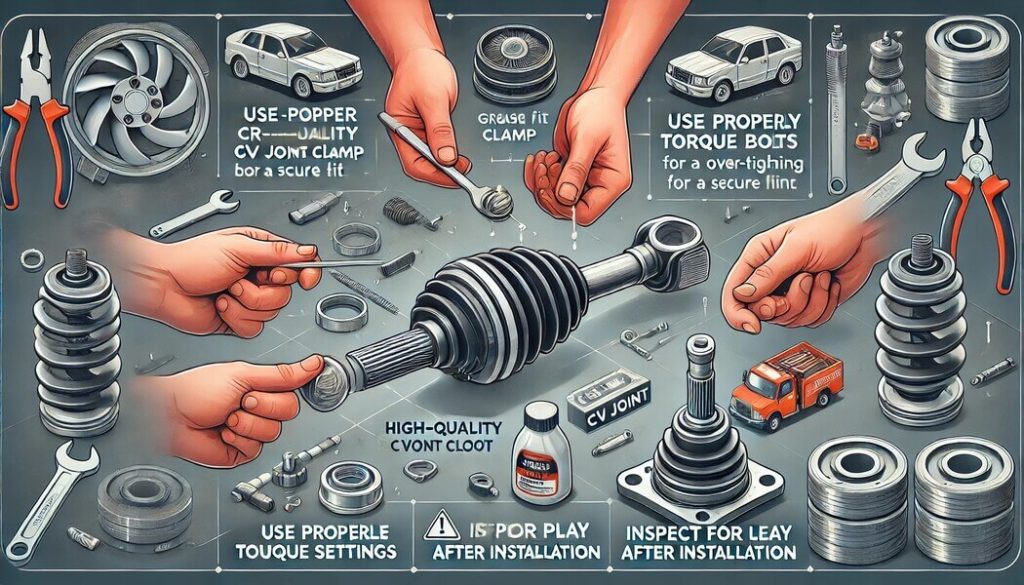Last Updated on April 12, 2025 by Mark S. Taylor
Hey, have you ever heard a strange click or felt your car shake on the road? I’ve been there, and it scared me too—it’s how I learned how to diagnose bad CV axle issues. As a DIY mechanic who’s fixed my own cars, I know the panic of wondering if your CV axle is failing, like when I ignored a clicking noise and almost wrecked my budget. Trust me, I’ve got the know-how from hands-on fixes and pro advice, and I’ll show you why catching cv axle symptoms early is key. Stick with me, and let’s figure out how to check for CV axle damage together—your car will thank you!

Contents
What Is a CV Axle, Anyway? A Quick Breakdown
Hey, let me clear this up for you—it’s simpler than it sounds. The CV axle, or Constant Velocity axle, links your wheels to the transmission, sending power smoothly even when you turn or hit bumps. It has inner and outer CV joints, wrapped in rubber boots with grease inside, like a well-oiled team keeping things rolling. Short answer: A CV axle connects wheels to the transmission for smooth power transfer.
Trust me, it’s a big deal if it fails. I learned that the hard way when my car wouldn’t turn right after a boot tore—it felt like losing control on ice. If the CV axle or joints break, you lose power to the wheels, which can be scary and dangerous on the road. Short answer: A bad CV axle risks losing wheel power and control.
I’ve seen this myself, and it’s why I check mine regularly now. If you’re hearing clicks or feeling wobbles, look out for cv joint symptoms or how to tell if front CV joint is bad—it could save you from a breakdown. Think of it as your car’s lifeline; keep it strong, and you’ll stay safe. Short answer: Check for CV joint symptoms to prevent safety issues.
Common Symptoms of a Bad CV Axle (From My Own Repairs)
Hey, let me share what I’ve learned from fixing my own cars—it’s like a heads-up from a friend. The first sign I noticed was a loud “click-click” when turning sharp corners in my old Honda, usually from a failing outer CV joint. It sounded like someone snapping their fingers right under the car! Short answer: A clicking noise when turning signals a bad outer CV joint.
Another clue was vibration while driving. My steering wheel shook at high speeds, and it felt like I was on a bumpy road—it turned out my inner CV joint was worn out. I panicked at first, but checking cv joint noise when driving straight saved me from bigger trouble. Short answer: Vibration at high speeds means a worn inner CV joint.
I also heard clunking or knocking sounds when I accelerated or braked hard, pointing to a bad inner CV joint or loose axle. And once, after a long drive, I found black grease on my tire’s inside edge—a clear sign of a torn CV boot letting grease out. Short answer: Clunking or grease leaks indicate a bad CV joint or boot.
The scariest was wheel shaking at high speeds, like my front end wobbled at 50 MPH—it was terrifying until I figured out the CV axle was imbalanced. I ignored a clicking noise for weeks, thinking it was road noise, but it got worse—my mechanic said the joint was almost gone. Now I check for symptoms of bad inner CV joint regularly! Short answer: Look for shaking, clunking, or leaks to catch CV axle issues early.
How to Diagnose Bad CV Axle: Step-by-Step (Safely!)
Hey, let’s tackle this together—I’ve been in your shoes, worried about a shaky car. Before you start, park on flat ground, set the brake, and use jack stands—never just a jack, trust me. I nearly dropped my car once while checking an axle, so wear gloves and glasses too; grease and dirt can get messy fast. Short answer: Use jack stands and safety gear to diagnose safely.
First, do a visual check. Crawl under your car and look at the CV boots for tears or cracks—I found one split open once, leaking grease all over. If you spot grease on the tire or ground, it’s a big red flag, like a warning light flashing. Short answer: Check CV boots for tears or grease leaks.
Next, test for play. Jack up the car safely, support it with stands, and grab the wheel. Push and pull it side to side; if it wobbles too much, the CV joint or axle might be loose. I felt that wobble on mine once—it was my clue something was wrong. Short answer: Push the wheel to check for loose CV joints.
Then, take it for a spin in a parking lot. Turn sharp in reverse and listen for clicks or clunks—I heard a loud pop turning left, and that nailed my outer joint issue. It’s like your car talking to you, so pay attention. Short answer: Test drive to hear clicking or clunking noises.
Finally, listen while driving straight. Speed up and slow down; a clunk or vibration could mean inner CV joint trouble, like I hit on a highway trip. Never drive if you suspect damage—it can snap and leave you stranded, as I barely avoided once with a loud knock. Short answer: Listen for clunks while driving; don’t drive if you suspect damage.
Visual Aids: What to Look For (Imagine These!)
Hey, pictures and videos can make all the difference—I wish I had them when I started. Imagine seeing a healthy CV boot next to a torn one, with grease leaking out—it’s like night and day. These visuals show you exactly what cv boot tear signs look like, so you don’t miss a thing. Short answer: Visuals show healthy vs. torn CV boots clearly.
Now, picture a video of jacking up a car safely with stands, zeroing in on the CV axle spot. It’s a lifesaver for safety, like a map showing you where to look. I learned this the hard way, and it’s why I suggest focusing on the CV axle location every time. Short answer: Videos demonstrate safe jacking and CV axle location.
Think about a test drive clip, catching that clicking noise when turning—it’s like your car whispering its problems. I heard that click once, and seeing it in action would’ve sped up my fix. It helps spot worn CV joint test signs fast. Short answer: Videos highlight clicking noises for quick diagnosis.
Finally, imagine a worn CV joint with beat-up bearings side by side with a good one. It’s proof in pictures, making your cv axle inspection checklist easier to follow. I’ve been there, confused by what “worn” means, but visuals cleared it up for me. Short answer: Compare worn and good CV joints visually for accuracy.
What Happens If You Ignore It? (My Cautionary Tale)
Hey, don’t make the same mistake I did—ignoring a bad CV axle can be costly and scary. I once drove with a leaking boot, and it wrecked my transmission, racking up a $500 repair bill when the joint seized. It also made my wheels shake at high speeds, like driving on shaky ground—it was tough to steer. Short answer: Ignoring a bad CV axle can damage transmission and cause shaking.
Let me tell you, it’s dangerous too. Driving with a bad CV axle is like playing with fire—it can snap out of nowhere, leaving you unable to steer. I almost crashed once when mine vibrated wildly on a curve, but I got lucky. Now I check for signs of bad CV axle right away. Short answer: A bad CV axle can snap, making driving unsafe.
I’ve learned my lesson, and you should too. If you hear clicks or see grease, don’t wait—it can affect your transmission or worse, as I found out. Think of it like a ticking time bomb under your car; fix it before it blows. Short answer: Fix a bad CV axle fast to avoid transmission damage and crashes.
FAQs About Diagnosing Bad CV Axles
How much does CV joint replacement cost when diagnosing a bad CV axle?
A: It costs $300 to $700, including parts and labor. I paid $450 for mine; prices vary by car. Short answer: CV joint replacement costs $300-$700.
Can a bad CV joint trigger the ABS light during diagnosis?
A: Not directly, but a damaged axle can affect sensors, turning on the ABS light. I fixed mine by replacing the axle. Short
answer: A bad CV joint might cause the ABS light indirectly.
How do I spot a bad front CV joint when diagnosing?
A: Look for clicks when turning or grease leaks on front wheels. I heard a click turning sharp and checked it fast. Short answer:
Check for clicks or leaks to diagnose a bad front CV joint.
Is driving safe with CV axle noise after diagnosis?
A: No, it’s risky. I drove once with noise, and it nearly failed. Check it ASAP to stay safe. Short answer: No, driving with CV axle noise is unsafe.
What causes outer CV joint failure in diagnosis?
A: Usually torn boots letting dirt in or wear from turns. My outer joint failed from a cracked boot. Short answer: Torn boots or wear cause outer CV joint failure.
My Final Thoughts on Diagnosing Bad CV Axles
If you’re a DIY mechanic who loves hands-on fixes and wants to save cash, my steps for how to diagnose bad CV axle are ideal for you. But if you’re not comfy under a car or need quick pro help, you might want to call a shop instead. Based on my scare with that clicking noise that led to a big repair, act fast—check for cv axle symptoms early, stay safe, and your car will roll smooth like a dream. Trust me, don’t wait like I did; your peace of mind is worth it!
